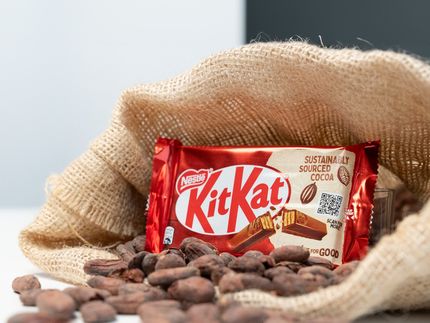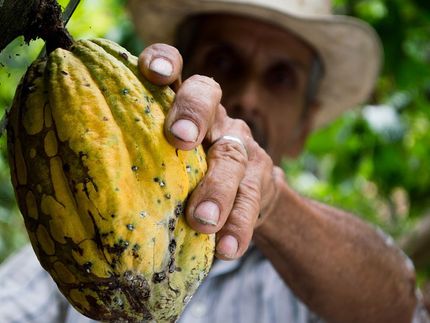Barry Callebaut Group – Half-Year Results
Advertisement
Antoine de Saint-Affrique, CEO of the Barry Callebaut Group, said: “We had a very strong performance in the first six months of the current fiscal year, which was supported by all product groups and regions, as well as our key growth drivers. This resulted in the continued improvement of our profitability, driven by a favorable mix, operational leverage and a more supportive market.”
In the first six months of fiscal year 2017/18 (ended February 28, 2018), the Barry Callebaut Group – the world’s leading manufacturer of high-quality chocolate and cocoa products – grew its
sales volume by +8.0% to 1,022,565 tonnes, which is significantly above the global chocolate confectionery market growth rate of +2.5%1. The Group’s growth in the second quarter was +8.1%. The strong volume growth was supported by all key growth drivers: Gourmet & Specialties (+7.1%), Outsourcing (+8.1%) and Emerging Markets (+11.0%), as well as the gradual recovery in market demand. Sales revenue declined by –1.8% in local currencies (+0.3% in CHF) to CHF 3,549.9 million, mainly due to lower cocoa and other raw material prices, which, based on the company’s cost-plus model, are for the majority of its business passed on to customers.
Gross profit amounted to CHF 553.0 million, corresponding to +15.5% in local currencies (+19.2% in CHF). The increase, which is significantly above volume growth, was fuelled by a good product and customer mix, and a more supportive market environment.
Operating profit (EBIT) improved by +12.3% in local currencies (+16.1% in CHF) and amounted to CHF 276.8 million, as a result of the increased gross profit. The increase of recurring EBIT was +20.6% in local currencies (+24.6% in CHF). On a recurring basis, the Group improved its EBIT per tonne by +11.6% in local currencies (+15.4% in CHF) to CHF 271.
Net profit for the period was up +17.6% in local currencies (+21.7% in CHF) to CHF 173.0 million. This was due to the strong increase in EBIT as well as lower net finance costs and despite higher income tax expenses due to a one-off impact of tax reforms in Belgium and the US. On a recurring basis, the net profit for the period was up +32.9% in local currencies (+37.5% in CHF).
Net working capital decreased by -16.0% from CHF 1,398.4 million in the same prior year period to CHF 1,174.7 million. The growth-related impact was offset by lower average raw material prices compared to prior year.
Free cash flow2 for the 6-month period under review increased to CHF 39.0 million compared to CHF – 32.1 million in prior year. This is largely due to the higher profitability, whereas all other items were largely offsetting. The free cash flow on a rolling 12-month basis amounted to CHF 546.7 million. This is the result of a stronger operating profit, lower working capital and continued discipline on capital expenditure (CAPEX).
Net debt amounted to CHF 1,208.4 million, down by –16.9% from CHF 1,454.9 million in the prior year period as a result of debt repayment out of the generated cash flow.
Outlook – Good portfolio visibility and diligent ‘smart growth’ execution
Looking ahead, CEO Antoine de Saint-Affrique said: “We continue to see healthy market dynamics. We have good visibility in our portfolio and together with the diligent execution of our ‘smart growth’ strategy, we feel confident to deliver on our 4-year guidance3.”
Strategic milestones achieved in the first six months of fiscal year 2017/18
- “Expansion”: The integration of the recent acquisitions of D'Orsogna Dolciaria in Italy, in October 2017, and Gertrude Hawk Ingredients in the US, in December 2017, further expanding Barry Callebaut’s value-adding Specialties & Decorations business, is well on track. Furthermore, to keep serving its customers optimally, Barry Callebaut invested in the expansion of its global chocolate production capacity in Region EMEA, Singapore and Region Americas.
- “Innovation”: Since its launch in September 2017 by Barry Callebaut, the fourth type of chocolate: Ruby, is hitting the consumer market. The first consumer-facing Ruby products were introduced in Japan and South Korea. Barry Callebaut also announced the launch of Ruby for the Gourmet & Specialties customers under the Callebaut brand. Furthermore, inspired by wine, coffee and craft beer categories, Barry Callebaut introduced a sensory language and tasting ritual for chocolate in January 2018. These tools will enable brands and artisans to help consumers appreciate chocolate even more than they do today. In addition, Barry Callebaut‘s sugar-reduced solutions are enticing customers and growing by double-digits.
- “Sustainability”: Barry Callebaut launched its first Forever Chocolate pilot in Indonesia. This is the first in a series of five pilot programs planned in cocoa origin countries that are intended to test theories of change in the quest to accelerate impact in sustainable cocoa production. Barry Callebaut is partnering with Dutch Wageningen University & Research which is providing the Group with robust, scientific support to provide the baseline and analytical framework against which the outcomes can be assessed.
Regional/Segment performance
Region EMEA – Exceptional volume growth
Barry Callebaut’s sales volume in Region EMEA went up by +9.6% to 471,120 tonnes, thus significantly outperforming the market, which grew +2.8%1. Growth was fueled by long-term outsourcing agreements, Gourmet and emerging markets within the Region, as well as the acquisition of D'Orsogna Dolciaria in Italy (since October 2017). Overall, sales revenue was almost flat at +0.4% in local currencies (+7.3% in CHF) and amounted to CHF 1,577.8 million.
On a recurring basis (excluding the one-off positive impact from prior year), operating profit (EBIT) was up by +12.1% in local currencies (+19.8% in CHF), reflecting the good product mix.
Region Americas – Accelerated performance in Q2
Sales volume in Region Americas increased by +5.5% to 265,904 tonnes, compared to the regional chocolate confectionery market which grew by +1.4%1. All countries in the region contributed to the Group’s volume growth, with a particularly strong performance in Brazil, Mexico and Canada. Sales revenue was flat in local currencies (–1.9% in CHF) and amounted to CHF 825.5 million. Operating profit (EBIT) increased by +9.2% in local currencies (+7.6% in CHF), as a result of a balanced product portfolio and further cost leverage in the region. The integration of the bolt-on acquisition of Gertrude Hawk Ingredients started in December 2017.
Region Asia Pacific – Double-digit growth
The Group’s sales volume growth in Asia Pacific reached +15.5% in the first six months, with strong double-digit growth in countries such as China, Indonesia, India and Japan. This performance significantly outpaced the underlying market growth of +4.0%1. Sales revenue went up by +4.6% in local currencies (+2.7% in CHF) to CHF 189.5 million. Operating profit (EBIT) grew in line with volume growth and increased by +15.6% in local currencies (+15.8% in CHF).
Global Cocoa – Strong momentum
The good momentum in the cocoa products market continued and was reflected in the strong sales volume growth of +6.2% to third-party, against the low base of prior year. Sales revenue declined by –7.6% in local currencies (–8.2% in CHF) due to lower cocoa product prices. Operating profit (EBIT) improved significantly by +130.5% in local currencies (+132.0% in CHF) as a reflection of a more supportive cocoa processing market environment, as well as some additional benefits from the Group’s ‘Cocoa Leadership’ project.
Raw material price developments
During the first half of fiscal year 2017/18 cocoa bean prices increased by +4.4%, from GBP 1,516 per tonne on September 1 2017 to GBP 1,582 per tonne on February 28, 2018. On average cocoa bean prices decreased by –23.1% versus prior year. A smaller-than-anticipated cocoa bean surplus at the end of the season, due to a slight drop in cocoa production and increasing market demand and growing financial speculation activity, started to put upward pressure on cocoa prices going forward. The combined ratio improved, due to lower cocoa bean prices as well as higher prices for cocoa butter.
Favorable weather conditions and good milk prices for farmers globally led to a considerable production increase worldwide since summer 2017. As a consequence, prices for milk powder dropped. World market prices for sugar moved lower, driven by large surpluses in the main producing countries. On the EU side, a record crop kept local prices at lower levels.




























































